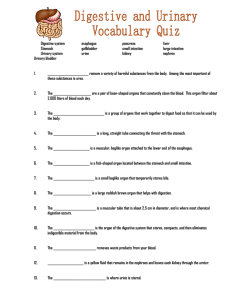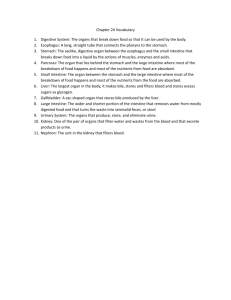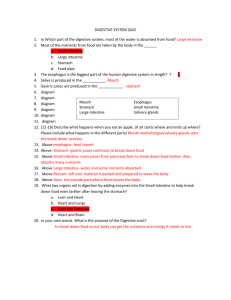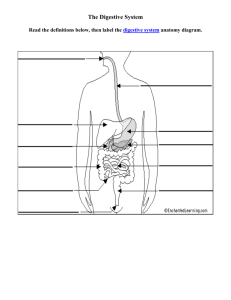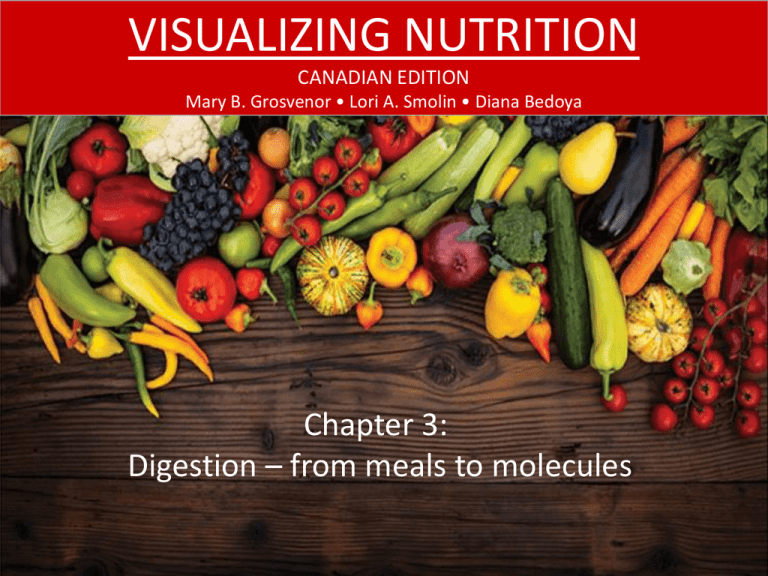
VISUALIZING NUTRITION
CANADIAN EDITION
Mary B. Grosvenor • Lori A. Smolin • Diana Bedoya
Chapter 3:
Digestion – from meals to molecules
CHAPTER 3: DIGESTION – FROM MEALS TO MOLECULES
LEARNING OBJECTIVES
At the end of this chapter, you should be able to:
• Describe the levels of structural organization of the
human body
• Compare and contrast how different nutrient classes
are digested and absorbed by the gastrointestinal
system
• Predict how changes to digestive structures and
functions contribute to disease
Levels of organization
ecosystems
populations
organisms
organ systems
organs
tissues
cells
organelles
molecules
atoms
ions
Levels of organization
Organ systems
Organ systems
Organ systems
Organ systems
Concept check
Which is the smallest?
a)
Tissue
b)
Molecule
c)
Cell
d)
Organ
Concept check
Which is the largest?
a)
Tissue
b)
Molecule
c)
Cell
d)
Organ
Concept check
Which is the largest?
a)
b)
c)
d)
Glucose
Carbon
Neuron
Heart
Concept check
Which is the smallest?
a)
b)
c)
d)
Glucose
Carbon
Neuron
Heart
Concept check
Place the following in order from the smallest to the
largest:
•
•
•
•
•
•
Organ system
Atom
Organ
Cell
Molecule
Tissue
Gastrointestinal system
Digestive system secretions
• Mucus is secreted from mucosal cells lining the
digestive tract. It moistens, lubricates and protects.
• Enzymes speed up reactions. In the digestive tract,
they help to break down larger molecules into smaller
ones.
• Hormones are chemical messengers produced by cells
in one body location, and delivered by blood to cells in
another location, where they elicit specific physiological
response.
Digestive enzymes
Mouth
• Mechanical and chemical digestion begins.
• Saliva is secreted from salivary glands in response to
the sight, smell, or presence of food. It contains
lubricants, enzymes (example: amylase to digest
starch), and other substances.
• Teeth break down food particles.
• Taste buds detect food chemicals.
• Tongue helps mix food and aids chewing.
Pharynx
• Part of digestive and respiratory systems.
• Epiglottis blocks food from entering the passageway to
the lungs (the larynx, the trachea, etc.) during
swallowing.
• If food enters the airway, it can be removed by coughing or the
Heimlich maneuver
Pharynx
Heimlich maneuver
Esophagus
• Connects pharynx to stomach
• Bolus of food is moved by rhythmic muscle
contractions called peristalsis
• Food passes through a muscular ring called a
sphincter at the end of the esophagus to enter the
stomach
Esophagus
Stomach
• Temporary storage of food
• Stomach (gastric) glands produce gastric juice
containing:
• Water
• Pepsinogen, inactive form of protein-digesting enzyme pepsin
• Hydrochloric acid that kills microorganisms, unfolds proteins,
activates pepsinogen to pepsin, and inhibits amylase
• Mucus protects stomach lining from pepsin and
hydrochloric acid
Stomach
• Muscular stomach lining helps mix food into semiliquid
chyme
• Little absorption; water, alcohol, aspirin,
acetaminophen (Tylenol) are absorbed
• Chyme leaves the stomach to enter the small intestine
through a pyloric sphincter
• Stomach emptying is regulated by signals from the small
intestines and is affected by meal size and composition
Stomach
Stomach
Small intestine
• Main site for digestion and absorption
• Chyme moved (pushed forward) by peristalsis and
mixed by rhythmic constrictions called segmentation
• About 6 metres long and large surface area due to
circular folds, villi, and microvilli (brush border)
• Undigested substances pass from the small intestines
to the large intestines through a sphincter
Small intestine
Small intestine secretions
• Pancreas secretes pancreatic juice containing:
• Bicarbonate: neutralizes the acid in the chyme (from the
stomach)
• Pancreatic amylase: digests carbohydrates into sugars
• Pancreatic proteases: digests proteins into amino acids
• Pancreatic lipases: digests fats into fatty acids
• Brush border secretes enzymes that complete
digestion of carbohydrates and proteins
• Liver secretes bile which emulsifies fat (breaks down
droplets) so lipases can access fat molecules
• Gall bladder stores bile
Small intestine chemical digestion
Transport across membranes
• Diffusion: movement of substances from areas of
higher concentration to areas of lower concentration
(down a concentration gradient)
• Simple diffusion: diffusion across membranes; no
energy required
• Osmosis: diffusion of water across membranes; no
energy required
• Facilitated diffusion: diffusion through a membrane; no
energy but protein carriers are required
• Active transport: movement of substances across
membranes against concentration gradients; requires
energy input (ATP) and a membrane protein
Small intestine absorption
Large intestine
• Colon and rectum
• Ends at the anus
• 1.5 metres long
• Absorption of water, some vitamins and minerals
• Bacteria digest some nutrients (for example, fiber) and
make vitamin K and some B vitamins
Rectum
• Last 20 centimetres of large intestines
• Stores feces
• Feces = undigested, unabsorbed matter, dead cells,
secretions from the gastrointestinal tract, water, and
bacteria
What a scientist sees
• Probiotics: food containing beneficial bacteria
• Prebiotics: food ingredients that stimulate growth of
beneficial bacteria
Digestive system summary
Gastrointestinal
tract
Mouth
Saliva
lubricates
Amylase
starts
starch
digestion
Chewing
breaks
down food
Pharnyx
Epiglottis
keeps food
from
airways
Esophagus
Peristalsis
starts
Stomach
Food
storage
Acid kills
bacteria,
unfolds
proteins,
activates
pepsin
Produces
chyme
Small
intestines
Most digestion
& absorption
Pancreatic
enzymes
digest food &
bicarbonate
neutralizes
acid
Bile breaks fat
Large
intestines
Absorb
water
Bacteria
digest
fiber,
make
vitamins
Rectum
Stores
feces
Concept check
Place the following in order starting at the lips:
•
•
•
•
•
•
•
•
Colon
Esophagus
Pharynx
Small intestine
Anus
Stomach
Mouth
Rectum
Concept check
For each of the following portions of the digestive tract,
name one function:
•
•
•
•
•
•
Mouth
Pharynx
Esophagus
Stomach
Small intestine
Large intestine
Digestive system & immune system
• Food contains antigens, molecules recognized by the
immune system as foreign
• Disease causing organisms (pathogens) have
antigens on their surfaces
• White blood cells in digestive system recognize and
destroy foreign antigens
• Phagocytes engulf and break down foreign
organisms
• Lymphocytes either destroy infected cells or secrete
antibodies which bind to antigens leading to their
destruction
Digestive system & immune system
Food allergies
• Immune system reacts to antigens called allergens
(substances causing allergic reaction)
• First exposure begins the process with production of
antibodies
• Second exposure: allergens bind to antibodies and
cause release of histamine
• Symptoms: redness, swelling, hives, tingling on tongue
or lips, difficulty breathing, decreased blood pressure,
vomiting, cramps
Food allergies
Celiac disease
• Inherited disease
• Gluten in wheat, barley, or rye acts as an antigen
• Immune response damages or destroys villi
• Symptoms and complications: abdominal pain,
diarrhea, fatigue, malnutrition, weight loss, anemia,
osteoporosis, intestinal cancer, and other chronic
illnesses
Debate
Should you be gluten free?
Heartburn & GERD
• Heartburn occurs when stomach contents including
acid moves from the stomach up into the esophagus
through the sphincter
• GERD = gastroesophageal reflux disease (gastro
means stomach) = recurring heartburn
• Symptoms and complications: burning sensation, pain,
bleeding, ulcers, cancer
Peptic ulcers
• Gastrointestinal tract lining is normally protected from
acid and pepsin by mucus
• Ulcers occur in esophagus, stomach, or small intestine
from damage to lining by stomach acid and pepsin
• Caused by: bacterium Helicobacter pylori (H. pylori),
aspirin and other pain relievers
• Symptoms and complications: pain, bleeding
Gallstones
• Solid material accumulates in the gall bladder and/or
bile ducts and blocks bile
• Symptom: pain
• After gall bladder removal, bile drips into the small
intestine rather than being secreted when fat is
consumed so fat content of meals needs to be reduced
Diarrhea
• Frequent, watery stools
• Occurs when substances move too quickly through the
large intestine for water to be absorbed or when water
is drawn from cells into the lumen of the intestines
• Caused by: infections, irritants, medications, diseases.
• Symptoms and complications: pain, dehydration,
malnutrition
Constipation
• Hard, dry stools which are difficult to pass
• Caused by: too little water and fiber in the diet, lack of
exercise; decreased strength of large intestinal
muscles, medications
Digestive system disorders
Digestive system disorders
Apply to your life
What are digestive problems you have experienced
(personally or with a family member or friend) in the
past?
To which foods are you, your family, or your friends
allergic?
Thinking it through
Digestive & cardiovascular systems
• Water-soluble nutrients are absorbed into small blood
vessels called capillaries
• Lipid-soluble nutrients are absorbed into lymph vessels
called lacteals
• Blood from the digestive system enters the portal
circulation and first travels to the liver for detoxification
and conversion and storage of some nutrients
Liver & portal system
Cardiovascular system
• Nutrient-rich blood and lymph return to the heart to be
pumped out to the body
• Arteries carry blood away from the heart and branch
into arterioles and deliver blood to capillaries
• Capillaries drain into venules which fuse to form veins
which return blood to the heart
Cardiovascular system
• Pulmonary circuit: the heart pumps blood to the lungs
for removal of carbon dioxide and to pick up oxygen
• Systemic circuit: the heart pumps blood to body tissues
and cells to deliver oxygen and nutrients and pick up
carbon dioxide and wastes
• Gases, nutrients and metabolic waste products are
exchanged across capillary walls
Removal of wastes
Cardiovascular system
Interpreting data
Based on this chart, to which area does exercise cause
the greatest reduction in blood flow?
a)
b)
c)
d)
Skeletal muscle
Abdomen
Other organs
There is no change
Lymphatic system
• Absorbs fat-soluble nutrients
• Removes fluid from tissues and filters it before
returning it to the blood
• Contains immune cells to fight antigens
Metabolism
• Breakdown (catabolism) or synthesis (anabolism) of
molecules
• Changes to molecules occur in a series of reactions
within metabolic pathways
• Cells use nutrients for energy or to build structures and
regulatory molecules
• Excess nutrients can be stored in the body as fat
Metabolism example: cellular
respiration
• Cells use oxygen to convert glucose, fatty acids, and
amino acids into carbon dioxide, water, and energy in
the form of ATP
• ATP (adenosine triphosphate) contains high-energy
bonds the cell can break to release energy to do work
(such as muscle contraction, active transport across
membranes, etc.)
Metabolism
What are similarities and differences
between the:
• Mouth and small intestine
• Esophagus and stomach
• Esophagus and small intestine
• Stomach and small intestine
• Small intestine and large intestine
• Colon and rectum
Nutrition in the news
• Gluten-free diets
• Gastric bypass and lap band surgery
Checking student learning outcomes
• What is the correct order for the body’s levels of
organization from smallest to largest?
• As food moves from the mouth to the anus, through
which structures does it pass? What are the functions
of each?
• What can go wrong with the structures and functions of
the digestive system?
COPYRIGHT
Copyright © 2014 John Wiley & Sons Canada, Ltd.
All rights reserved. Reproduction or translation of
this work beyond that permitted by Access Copyright
(The Canadian Copyright Licensing Agency) is
unlawful. Requests for further information should be
addressed to the Permissions Department, John
Wiley & Sons Canada, Ltd. The purchaser may make
back-up copies for his or her own use only and not
for distribution or resale. The author and the
publisher assume no responsibility for errors,
omissions, or damages caused by the use of these
programs or from the use of the information
contained herein.




